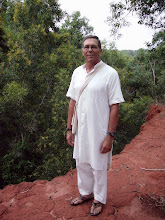Wednesday, Feb. 20, 08
On every bus there are two key people, the driver and the monitor. The monitor collects payment, keeps track of people's needs, and indicates the correct stop. That stop comes for me after 6 hours out of KK, road side where I am picked up by a mini van and transported to the village of Bilit. A short crossing of the river, 300 ft. wide, and I am ushered to my lodging by a portly man. First comes an evening cruise. Present are two French couples and their 5 children, Patrick, a 56 year old man, and me. Here are some of the birds and monkeys we saw that evening - Oriental Pied Hornbill, Lesser Fish-Eagle, Pacific Swallow, Great Egret, Little Egret, Oriental Darter/Snake Bird, Stork Billed Kingfisher, Black Hornbill, Long Tailed Macaque, Flying Fox, and the Silver Langgur. In the evening we take an hour walk into the jungle. Fearless Luis picks up a 3" scorpion. Anyone want to handle it? No takers! Onward through leech infested marshes, which is the rainforest. Most of us return with at least one leech attached, I have one. When a leech attaches, spray it with some repellant and flick it off. If it has stayed a while, you will find a red spot, 1/2" in diameter which continues bleeding. No disease is transferred. One of the ways they detect us is through carbon dioxide, and also the smell of blood.
The next morning we head into the jungle, boots are supplied for each of these treks. This is mostly secondary jungle, some primary, which means it has been logged. This logging took place around 50 years ago and still there is evidence that the jungle has not recovered. In fact, a jungle can dry out and compact leaving it vulnerable to dying off. Leeches are a constant menace. Every several few minutes we individually stop to check ourselves. Our order changes depending on who is flicking. A highlight is a small 2" squirrel which comes to within several feet of us. Touching plants indiscriminately is cautioned against. There is poison ivy present. If it is in a tree, rain can drip it's poison on you. Returning, I remove my clothing for a shower. 5 leeches have attached themselves to me undetected. Following the flicking of one, I bleed for 10 minutes. The French families eat together. Their children aged 2-10 are good sports. The couples do as much as then can and then keep the children in camp as they take turns going on the activities. There is reforestation of the heaviest logged areas where bushes and grasses have returned. A tree can be purchased and planted in your name. A corrider of life has been established along the river for the pygmy elephants. But, this jungle is disappearing to the palm oil companies and loggers.
Another evening cruise puts us face to face with a herd of 30-40 elephants. The young are encircled by the mothers as they continue chomping. Later, we find another grouping, around 15 this time. What a treat.
This morning is another cruise and a 1 1/2 hour drive to Sandakan. I have decided to not go to Sepilok, the orangutan rehabilitation center. It appears it is much like a zoo.
How long will such jungle last? 10 or 15 years? Not much more, unless some pressure can be brought.
Subscribe to:
Post Comments (Atom)

1 comment:
Did anyone ever tell you to pour salt onto the leeches? The salt will dry out the leeches - and they are easier to pull off with little bleeding!
Sounds like you are having quite the adventure! How is your Indo language coming along?
Post a Comment